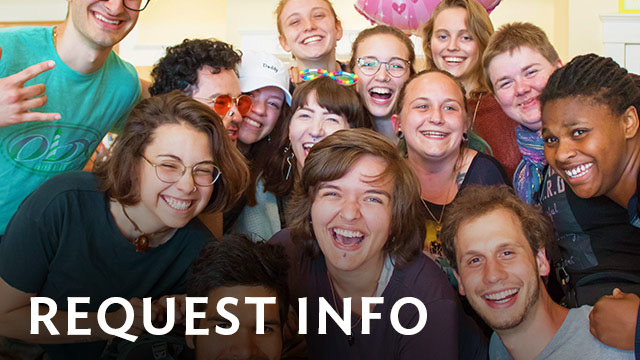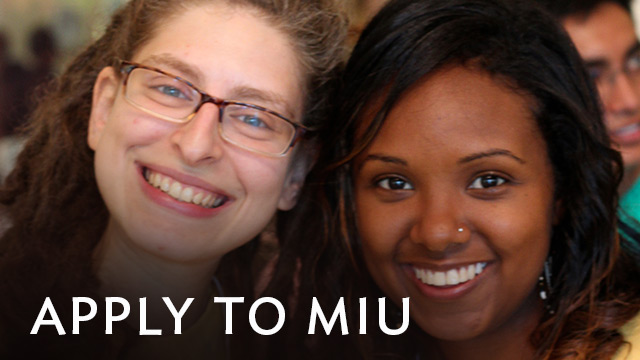Establish your voice as an artist through interactive studio practice, online seminar courses, and dialogue with faculty, peers, and visiting artists
- Develop the skills to succeed as a professional artist, arts educator, or in senior positions in art-related careers
- Cultivate a professional, sustainable studio practice to engage in a life in art
- Learn to create works of art that reflect a sophisticated understanding of the particular forms, materials, and processes of your chosen medium
- Engage in a dynamic, critical conversation with faculty and peers, and have regular one-on-one meetings with visiting artists
- Culminate your experience with a thesis exhibition in the newly-renovated Wege Center for the Arts
- Federal loans for this program typically cover tuition and up to $17,000 per year towards living expenses for US students
- 3-Week No-Cost Trial: see if MIU is the right fit for you
Cultivate a sustainable studio practice
 The Low Residency MFA in Visual Art gives you the opportunity to pursue an in-depth graduate-level experience in art that is flexible and tailored to your individual needs. You also cultivate a community of support around your practice, developing friendships and connections to sustain your life in art.
The Low Residency MFA in Visual Art gives you the opportunity to pursue an in-depth graduate-level experience in art that is flexible and tailored to your individual needs. You also cultivate a community of support around your practice, developing friendships and connections to sustain your life in art.
Meditate and Create
 At MIU, you’ll learn the Transcendental Meditation® (TM)® technique. This simple technique for inner peace and wellness, along with MIU’s unique Consciousness-BasedSM education, allows you to access your creative imagination and illuminate deeper connections in your life and work.
At MIU, you’ll learn the Transcendental Meditation® (TM)® technique. This simple technique for inner peace and wellness, along with MIU’s unique Consciousness-BasedSM education, allows you to access your creative imagination and illuminate deeper connections in your life and work.
Work directly with nationally-recognized faculty and artists
 As a low-residency MFA student, you’ll work directly with a rotating roster of visiting artists during summer and winter residencies, and will meet in person with a visiting artist mentor in your home studio during remote semesters. Additionally, you’ll have the opportunity to participate in our regular on-campus visiting artist lecture series throughout the semester via webinar.
As a low-residency MFA student, you’ll work directly with a rotating roster of visiting artists during summer and winter residencies, and will meet in person with a visiting artist mentor in your home studio during remote semesters. Additionally, you’ll have the opportunity to participate in our regular on-campus visiting artist lecture series throughout the semester via webinar.
Program structure
 In our 2.5-year, 60-credit program, students attend two-week studio-intensive residencies on the MIU campus in the summer and winter, and complete independent studio work during the fall and spring semester, supervised remotely by faculty. Students will also enroll in an online graduate seminar course during remote semesters, meeting online weekly with the rest of their cohort for discussions and presentations. Finally, each remote semester, students will be assigned a visiting artist mentor in their region to meet with in-person on a monthly basis.
In our 2.5-year, 60-credit program, students attend two-week studio-intensive residencies on the MIU campus in the summer and winter, and complete independent studio work during the fall and spring semester, supervised remotely by faculty. Students will also enroll in an online graduate seminar course during remote semesters, meeting online weekly with the rest of their cohort for discussions and presentations. Finally, each remote semester, students will be assigned a visiting artist mentor in their region to meet with in-person on a monthly basis.
Courses & degree requirements
In this 60-credit, 2.5 year MFA program, students attend on-campus residencies of two weeks duration once per semester. That means a total of 6 residencies — 5 studio residencies plus a final Thesis Exhibition residency. During the remainder of the semester, students take courses and interact with their faculty online.
More detail
Areas of study
- 2D (Painting and Drawing)
- 3D (Sculpture, Ceramics, Installation, Video and Performance Art)
Courses
- Transcendental Meditation Course, 1 credit
- Summer and Winter Residencies, 5 @ 2 cr = 10 credits
- Capstone Residency, 2 credits
- TM and the Creative Process (online course in the first semester), 2 credits
- Graduate Seminar, 5 @ 4 cr = 20 credits
- Remote Independent Studio Work, 5 @ 4 cr = 20 credits
- Visiting Artist Evaluations and Response, 5 @ 1 cr = 5 credits.
Students attend on-campus summer and winter residencies made up of:
- Three 2-week (4 credit) summer sessions with students on campus working in MIU studios.
- Two 2-week (4-credit) winter sessions on campus. The last 3 days of the first winter session consist of a TM Retreat. Students have the option to add a retreat in the successive sessions.
- In a Capstone Residency at the end of the fifth semester, students mount a thesis exhibition on campus and make a final presentation or thesis defense.
TM and the Creative Process (2 credits)
During the first campus residency, students are introduced to the key ideas of TM and the Creative Process and then complete that study through the course ART 508 TM and the Creative Process online to fulfill this university requirement for graduate students.
Graduate seminar (20 credits)
Students are required to remain enrolled in the ongoing Graduate Seminar (4 credits per remote semester) in all five remote semesters. The seminar is divided into sections for the first- and second-year cohorts. The seminar meets online as a group once per week, and students are expected to participate in an online Discussion Forum by responding to prompts created by the seminar faculty. A weekly webinar conducted in a Zoom-style discussion based on students’ research is designed to accumulate over the course of the program.
Once a year, the seminar will include a field trip when students and faculty meet for a 5-day intensive in NYC or another major city to visit galleries, museums, and artists’ studios.
Remote independent studio work (20 credits)
This comprises the bulk of the workload between on-campus residencies (5 credits per semester). Students are expected to spend a minimum of 15 hours per week working independently in their studio. Documentation of works/process/progress is assessed on a monthly basis by the program director, including monthly individual online meetings between the student and program director.
Visiting artist evaluations and response (5 credits)
During remote semesters, students consult with the Program Director to choose a regional artist who visits with the student in person for at least 90 minutes four times throughout the semester (1 credit per semester).
To graduate, students must also satisfy the general requirements for a master’s degree
Get started by contacting Adriene
 Adriene Crimson is this program’s admissions counselor for US students. Adriene will provide you with all the details of becoming a student, including connecting you with the program director or faculty.
Adriene Crimson is this program’s admissions counselor for US students. Adriene will provide you with all the details of becoming a student, including connecting you with the program director or faculty.
International applicants may connect with us through our international inquiry form.
Next entry: Jul 2026Apply Now >
Next entry: Jul 2026Apply Now >



